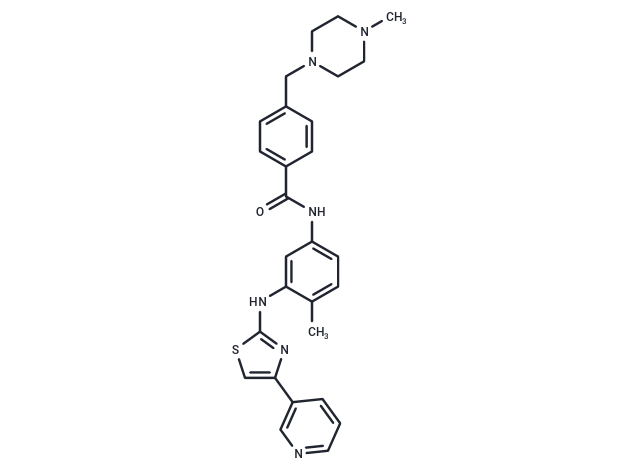Shopping Cart
- Remove All
 Your shopping cart is currently empty
Your shopping cart is currently empty

Masitinib (AB1010) is a tyrosine-kinase inhibitor used in the treatment of mast cell tumors in animals, specifically dogs. Since its introduction in November 2008 it has been distributed under the commercial name Masivet. It has been available in Europe since the second part of 2009. In the USA it is distributed under the name Kinavet and has been available for veterinaries since 2011.

| Pack Size | Price | Availability | Quantity |
|---|---|---|---|
| 5 mg | 29 € | In Stock | |
| 10 mg | 45 € | In Stock | |
| 50 mg | 85 € | In Stock | |
| 100 mg | 153 € | In Stock | |
| 200 mg | 239 € | In Stock | |
| 1 mL x 10 mM (in DMSO) | 47 € | In Stock |
| Description | Masitinib (AB1010) is a tyrosine-kinase inhibitor used in the treatment of mast cell tumors in animals, specifically dogs. Since its introduction in November 2008 it has been distributed under the commercial name Masivet. It has been available in Europe since the second part of 2009. In the USA it is distributed under the name Kinavet and has been available for veterinaries since 2011. |
| Targets&IC50 | PDGFRβ:800 nM, Abl-1:1.20 μM, LynB:510 nM, c-Kit:200 nM, PDGFRα:540 nM |
| In vitro | Compared to a placebo, Masitinib (at a dosage of 12.5 mg/kg/d PO) significantly increased the overall TTP (tumor progression time) in dogs. In the Ba/F3 transplant tumor model expressing Δ27, Masitinib at 30 mg/kg inhibited tumor growth and extended the average survival time, without exhibiting cardiotoxicity or genotoxicity. Additionally, the combination of Masitinib and gemcitabine demonstrated a synergistic inhibitory effect on the proliferation of gemcitabine-resistant cell lines, Mia Paca2 and Panc1. |
| In vivo | Masitinib inhibits the proliferation of Ba/F3 cells expressing human wild-type KIT induced by stem cell factor, with an IC50 of 150 nM, and the proliferation induced by IL-3 with an IC50 value of >10 μM. In Ba/F3 cells expressing PDGFR-α, masitinib suppresses PDGF-BB-stimulated proliferation and PDGFR-α tyrosine phosphorylation, with an IC50 of 300 nM. At concentrations of ≤500 nM, masitinib acts as an ATP-competitive inhibitor. It also effectively inhibits recombinant PDGFR and the intracellular kinases Lyn and FGFR3. However, masitinib exhibits weak inhibition of ABL and c-Fms. In mammalian cell lines and BMMC, masitinib inhibits SCF-induced human Kit tyrosine phosphorylation. It inhibits KIT gain-of-function mutations in Ba/F3 cells, including the V559D and Δ27 mouse mutations, with IC50 values of 3 and 5 nM, respectively. In two novel ISS cell lines, masitinib inhibits cell growth and PDGFR phosphorylation, indicating its activity against primary and metastatic ISS cell lines and its potential utility in ISS clinical management. Masitinib provides stronger inhibition than imatinib on degranulation, cytokine production, and migration of bone marrow mast cells. It inhibits the proliferation of mastocytoma cell lines, including HMC-1α155 and FMA3, with IC50 values of 10 and 30 nM, respectively. |
| Kinase Assay | In vitro enzyme-linked immunoassay with recombinant protein kinases: A 96-well microtitre plateis coated overnight with 0.25?mg/ml poly(Glu,Tyr 4:1), rinsed twice with 250?μL of washing buffer (10 mM phosphate-buffered saline [pH?7.4] and 0.05% Tween?20) and dried for 2 hours at room temperature. Assays are performed at room temperature with a final volume of 50?μL in kinase buffer (10 mM?MgCl2, 1 mM MnCl2, 1 mM sodium orthovanadate, 20 mM HEPES, pH?7.8) containing ATP at a concentration of at least twice the Km for each enzyme and an appropriate amount of recombinant enzyme to ensure a linear reaction rate. Reactions are initiated upon introduction of the enzyme and terminated with the addition of one reaction volume (50 μL) of 100?mM EDTA per 5?M urea mix. Plates are washed three times and incubated with 1:30,000 horseradish peroxidase-conjugated anti-phosphotyrosine monoclonal antibody, then washed three times and incubated with tetramethylbenzidine. The final reaction product is quantified by spectrophotometry at 450?nm. |
| Cell Research | For the assay of Ba/F3 cell proliferation, microtitre plates are seeded with a total of 104 cells/well in 100 μL of RPMI 1640 medium with 10% foetal bovine serum at 37 °C. These are supplemented, or not, with either 0.1% conditioned medium from X63-IL-3 cells or 250 ng/mL murine SCF. The murine SCF, which activates Kit, is purified from the conditioned medium of SCF-producing CHO cells. Cells are grown for 48 hours at 37 °C with Masitinib and then incubated with 10 μL/well of WST-1 reagent for 3 hours at 37 °C. The amount of formazan dye formed is quantified by its absorbance at 450 nm using a scanning multiwell spectrophotometer. A blank well without cells is used as a background control for the spectrophotometer. (Only for Reference) |
| Alias | AB1010 |
| Molecular Weight | 498.64 |
| Formula | C28H30N6OS |
| Cas No. | 790299-79-5 |
| Smiles | N(C1=NC(=CS1)C=2C=CC=NC2)C3=CC(NC(=O)C4=CC=C(CN5CCN(C)CC5)C=C4)=CC=C3C |
| Relative Density. | 1.280 g/cm3 (Predicted) |
| Storage | Powder: -20°C for 3 years | In solvent: -80°C for 1 year | Shipping with blue ice. | ||||||||||||||||||||||||||||||||||||||||
| Solubility Information | DMSO: 60 mg/mL (120.33 mM) H2O: < 1 mg/mL (insoluble or slightly soluble) Ethanol: 4 mg/mL (8.02 mM) | ||||||||||||||||||||||||||||||||||||||||
Solution Preparation Table | |||||||||||||||||||||||||||||||||||||||||
Ethanol/DMSO
DMSO
| |||||||||||||||||||||||||||||||||||||||||

Copyright © 2015-2024 TargetMol Chemicals Inc. All Rights Reserved.